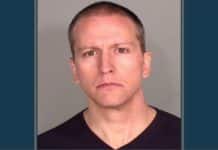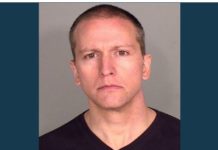April 14 (UPI) — A use-of-force expert for the defense testified that former Minneapolis police officer Derek Chauvin was “justified” in the amount of force he used to detain George Floyd, as the prosecution rested its case in his murder trial Tuesday.
Barry Vance Brodd, a consultant on police practices and use of force who was hired by the defense, testified that he spent 60 hours reviewing video of the fatal Memorial Day arrest of the 46-year-old Floyd. He determined Chauvin used a reasonable amount of force.
“I felt that Derek Chauvin was justified, was acting with objective reasonableness following Minneapolis Police Department policy and current standards of law enforcement in his interactions with Mr. Floyd,” Brodd said.
Chauvin, a fired Minneapolis police officer, has been charged with second-degree murder, third-degree murder and second-degree manslaughter in Floyd’s death on May 25. The defense has argued that Floyd died of a drug overdose and other health issues, not due to Chauvin placing his knee on his neck for nearly 10 minutes.
Brodd, who served as a police officer for 29 years and is certified by the FBI as a police defensive tactics officer, said he does not consider placing a person in the prone position as a use of force, stating that it would prevent them from choking if they vomited and is considered the best position to avoid inflicting pain on a subject.
He added that police body camera video showed Floyd kicking one of the officers who was restraining him while he was on the ground.
Under cross-examination from the prosecution, Brodd said that if officers inflict pain on a person held in the prone position it could be considered a use of force and that placing a person in the prone position could lead to positional asphyxiation, which witnesses for the prosecution testified was Floyd’s cause of death.
Brodd said officers are trained on the risk of placing a suspect in the prone position and said a person should be placed on their side at the first sign it appears they are in distress.
Prosecutor Steve Schliener played video showing Floyd asking for water as he said “my stomach hurt, my neck hurt, everything hurt,” which Brodd said “could” constitute an expression of pain.
Brodd further testified that he heard Floyd’s pleas during his review of the evidence of the case but “did not necessarily note it.”
Minneapolis Park Police Officer Peter Chang testified that he responded to the Cups Food store where Floyd was arrested after hearing a radio dispatch requesting backup.
Chang said Floyd was handcuffed and seated on the sidewalk outside of Floyd’s Mercedes-Benz SUV and that officers asked him to confirm Floyd’s name and date of birth and watch the vehicle to ensure no one tried to enter it.
He said a crowd that had gathered in the area as officers attempted to move Floyd to the squad car were “very aggressive” toward the officers and that he felt concerned for their safety.
Footage from Chang’s body camera showed him around the corner from where Floyd was arrested and away from the crowd and he confirmed that he could “no longer see what was going on” with Floyd from that location.
Shawanda Hill, a friend and former girlfriend of Floyd’s, testified that she was in the car with Floyd at the time of his arrest after she saw him at the Cups Food store with Morries Hall, who was identified as a suspected drug dealer during the trial, and he offered her a ride.
She said Floyd appeared “happy, normal, talking, alert” in the store and told her he was “tired because he had been working.”
Hill testified that Floyd fell asleep about 8 minutes after getting into the car parked outside of the store and that she and Hall tried to wake him up several times, including when store employees came out to question him about allegedly using a $20 bill to purchase cigarettes.
“He’d wake up, say something, made a little gesture and nodded back off,” she said.
She said Floyd woke up when he saw an officer draw his gun outside his vehicle and immediately put his hands on the steering wheel as he pleaded “Please, please don’t shoot me.”
Retired Minneapolis police officer Scott Creighton was also called to testify about a May 6, 2019, arrest of Floyd as a passenger at a traffic stop.
Judge Peter Cahill instructed the jury that any discussion of drugs during the arrest was intended to show that ingestion of opioids may have affected the physical wellbeing of Floyd and was not to be used to reflect on Floyd’s character.
Body camera footage from the 2019 arrest showed Creighton approaching the window of Floyd’s vehicle with his gun drawn ordering Floyd to place his hands on the dashboard as another officer approached from the driver’s side of the vehicle telling Floyd to place his hands on his head and spit out something he had put in his mouth while threatening to deploy a stun gun.
“Don’t shoot me. Please don’t shoot me,” Floyd can be heard saying in the footage, later telling Creighton, “Don’t beat me up.”
As the video shows Floyd being placed into handcuffs, he can be heard saying “I apologize, man.”
Creighton described Floyd’s behavior as “very nervous, anxious” prompting an objection from prosecutors, with Cahill agreeing to strike the answer from the record.
Creighton said the situation “escalated real quick,” saying he drew his gun because Floyd did not initially show his hands and that he and the other officer “had to forcibly handcuff him.”
He said that Floyd was not in medical distress and did not collapse during the interaction.
Michelle Moseng, a retired Hennepin County Paramedic who responded to the police station where Floyd was taken after the 2019 arrest, said he told her he was addicted to opioids.
Moseng testified that while speaking to Floyd he said he had taken seven to nine Percocet pills and took one as the officers approached the vehicles.
“I asked him why?” she said. “He said it was because he was addicted.”
Moseng said she took Floyd’s vitals, noting that while his blood pressure was high, he had a normal heart rate and respiratory rate, was alert and obeyed commands.
She said Floyd initially appeared upset when she suggested he be taken to a hospital, but eventually allowed a crew to transport him there.
The trial entered its third week Monday with the judge rejecting a defense motion to sequester the jury due to a separate police shooting involving a Black man in the city.
The Minnesota Attorney General’s office led the prosecution in calling to the stand 38 witnesses, Minneapolis police officer and paramedics, law enforcement experts and medical experts in its case to prove that Floyd died from Chauvin pressing his knee into his neck.
Chauvin disregarded his training when he kneeled on Floyd’s neck as he was handcuffed behind his back, face down on the ground, for more than 9
minutes last year, Minneapolis Police Chief Medaria Arradondo testified last week.
Dr. Jonathan Rich, a cardiologist, rejected defense arguments that Floyd may have died due to a weak heart rather than trauma Chauvin inflicted by pressing his knee on Floyd’s neck. Rich testified that an autopsy showed an enlarged heart and narrow arteries was not sufficient to result in his death.
Rich, instead, concurred with previous medical witnesses, who said Floyd’s death was caused by low oxygen levels “induced by the prone restraint and positional asphyxia that he was subjected to.”
The prosecution also called bystanders who attempted to intervene to save Floyd, including the teenager who recorded the video footage showing Floyd, who was unarmed, dying as Chauvin kneeled on his neck, and her 9-year-old cousin. An off-duty Minneapolis firefighter who pleaded with officers to allow her to administer first aid to Floyd was also called to the stand.






